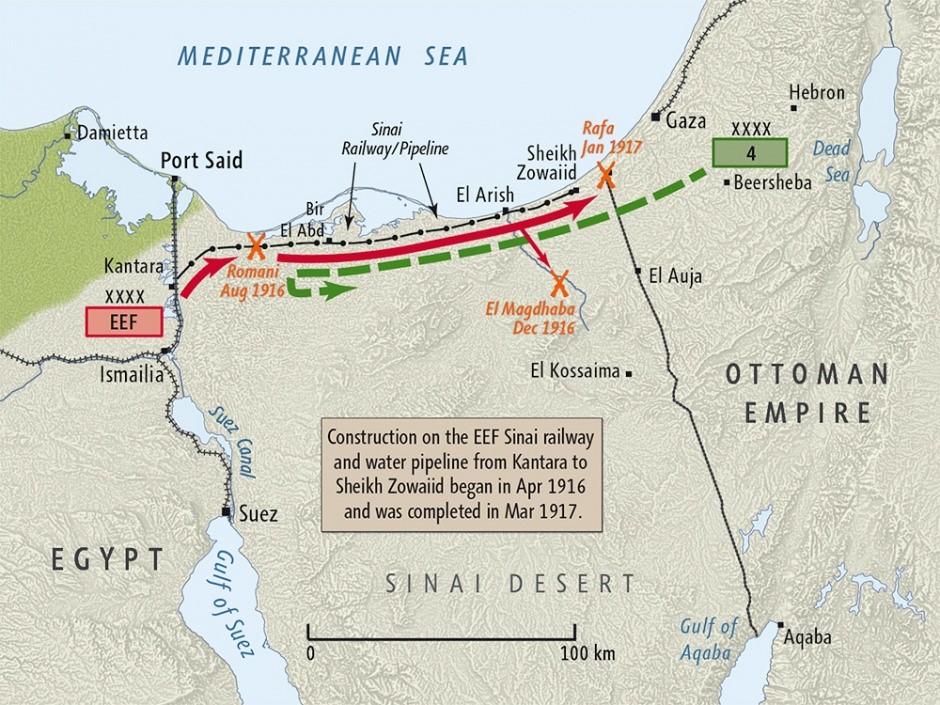In the months leading up to the battle of Romani the soldiers had been on patrol, watching the advancing Ottoman forces, trying to ascertain their numbers and strategies, learning where the water wells were and whether the water was suitable for human consumption, watering horses, or not at all, and trying to avoid the marauding bands of Bedouin that roamed the deserts. The water pipeline and railway line were being built along the Sinai to supply the troops, but to this point they had to make do with mainly bully beef and biscuits. There were no fresh vegetables or meat available and little water. June-July is mid-summer in the northern hemisphere and in the sizzling desert temperatures, many collapsed from heat stroke. In addition, the Sinai is prone to regular khamsin dust storms that whip up the fine sand, reduce visibility to almost zero and get into everything – nose, ears, throat and eyes.
Romani is situated 37 km from the Suez Canal. This oasis was the last stand before the canal and had to be held at all cost. Failure would mean Britain would lose control of the Canal. The British were holding the defence line with their 52nd division and two Australian regiments from the 1st Brigade guarded the southern flank. The attack came at 1.00 am on August 4, 1916 when 12,000 Turkish/German troops attempted to surround the British and ANZAC forces.

It was a fierce battle lasting two days. Brigadier General ‘Galloping’ Jack Royston is said to have gone through 14 mounts in one day, as he galloped along the Australian lines shouting “No surrender”. The Australians took the brunt of the action as they attempted to hold back the attackers, who outnumbered them ten to one. They held their five kilometer line unbroken but had to slowly retreat. The Turks got to within one kilometer of Romani. The ANZAC heavy resistance wore out their troops and thwarted the Turkish plan. When fresh reserves of ANZACs from the 2nd Brigade arrived at dawn, they were able to push back the exhausted Turks and eventually force their retreat. One thousand two hundred and fifty Turks were killed and 4,000 prisoners taken. From the Allied troops 202 were killed, 882 wounded and 46 missing, with most being ANZACs.
Significance of this Victory
The vital part that the ANZACs and their horses played was recognized by the British commander, Sir Archibald Murray, who said,
The ANZAC troops are the keystone of the defence of Egypt.1
From this point on, the British thinking changed from defence to attack. This was very significant. The ANZAC success meant they were often called to serve on the frontline, as they proved better in the trying desert conditions than either the ground troops or the cavalry.
After this defeat, the Ottoman forces withdrew without major resistance along the ancient Via Maris back to El Arish, some 80 km from Romani. Just when the soldiers thought they would be spending Christmas in the desert, they were ordered to advance to El Arish. On December 21, 1916, the allied forces entered El Arish, the last major outpost before the border, to find the Turks had deserted the post. Before they could rest properly, they were ordered to prepare for another ordeal at Magdhaba.
Endnotes:
- Australians in World War 1: Australian Light Horse, Dept of Vets Affairs 2007, 10
Pictures:
- Map produced by Geographx with research assistance from Damien Fenton and Caroline Lord. Map of 'Sinai campaign 1916 map', http://www.nzhistory.net.nz/media/photo/sinai-campaign-1916-map , (Ministry for Culture and Heritage), updated 14-Aug-2014

